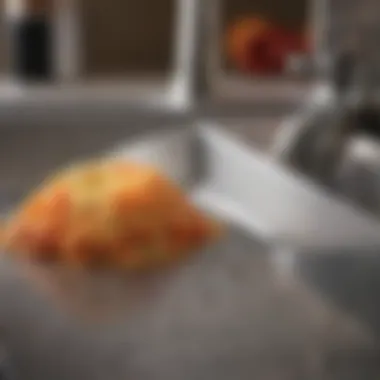Effective Solutions to Eliminate Garbage Disposal Odors


Intro
The garbage disposal is an essential kitchen appliance for many households. Its primary function is to shred food waste, enabling it to flow through plumbing systems easily. However, over time, some disposals can emit unpleasant odors that permeate the kitchen. Understanding the causes of these odors, along with effective cleaning methods, is crucial for maintaining a hygienic kitchen environment.
In this guide, we will explore the various factors that contribute to the smells emanating from garbage disposals. Emphasis will be placed on actionable steps and preventive measures that ensure optimal functionality and cleanliness of this vital appliance. By implementing these techniques, not only can one eliminate existing odors, but also proactively prevent similar issues in the future.
Key Points Discussed
- Common causes of odors in garbage disposals
- Preventative measures to minimize smell
- Effective cleaning techniques
- Overview of frequently overlooked factors
This discussion aims to educate readers thoroughly on managing and preventing unpleasant odors, thereby improving kitchen hygiene and functionality.
Causes of Garbage Disposal Odors
Understanding the root causes of odors is a critical first step. Food particles can become trapped in the disposal or the plumbing, leading to bacterial growth.
- Food Residue: Bits of food, especially those that are oily or high in protein, can stick around.
- Moisture: Leftover moisture can create a breeding ground for bacteria and mold.
- Aging Disposal: As disposals age, they may start to harbor lingering odors even after cleaning.
Regular inspection and maintenance can help mitigate these issues before they escalate.
Preventative Measures
To keep your garbage disposal odor-free, it is essential to adopt some preventative measures. Here are some effective strategies:
- Run Cold Water: Always run cold water for 15 seconds before and after using the disposal. Cold water helps solidify fats, making them easier to chop.
- Limit Certain Foods: Avoid putting fibrous or starchy waste down the disposal, like celery or potato peels, which can cause clogging.
- Regular Use: Use the disposal regularly to prevent food waste from stagnating.
Cleaning Techniques
Cleaning your garbage disposal effectively will help eliminate and prevent odors. Consider the following methods:
- Ice and Salt: Place a handful of ice cubes mixed with coarse salt into the disposal. Run the water and turn on the disposal. The ice helps to scrub away grime and clogs.
- Baking Soda and Vinegar: Pour half a cup of baking soda down the disposal, followed by one cup of vinegar. Let it fizz for a few minutes and then flush with hot water.
- Citrus Peels: Grinding citrus peels (like lemon or lime) can help freshen the disposal while leaving a pleasant scent.
End
Understanding the Problem
Grasping the issue of odors from garbage disposals is essential for anyone who values a clean kitchen environment. Garbage disposals are meant to help manage food waste efficiently, but they can also be a source of unpleasant smells. Understanding the root causes of these odors aids in effectively maintaining the disposal system. It informs users about the importance of regular upkeep and correct usage, turning a potential problem into manageable routine care.
What Causes Garbage Disposal Odors
Several factors contribute to foul odors in garbage disposals. Food particles that linger can decompose and generate unpleasant smells. Additionally, moisture trapped inside the disposal can cultivate bacteria. Another reason is the accumulation of grease, which can coat the blades and edges, trapping food debris. All these elements create an environment favorable for odors.
Recognizing these causes helps in taking proactive measures. For example, after every use, it is good practice to run water through the disposal to flush away particles. Awareness of these issues also promotes better hygiene overall.
Common Food Residues Contributing to Smells


Some food products are notably more problematic than others when it comes to odors in garbage disposals. For instance, fibrous vegetables like celery or asparagus tend to tangle and can cause clogs. Similarly, starchy foods such as potatoes can break down and become sticky, promoting decay. Other culprits include:
- Eggshells that can leave a sulfurous smell.
- Fish scraps which can create strong scents.
- Dairy products prone to becoming rancid.
Being aware of these troublesome food items allows users to avoid clogging and maintain a more pleasant environment.
Importance of Regular Maintenance
Regular maintenance of garbage disposals is critical in preventing bad odors. Many users overlook this aspect, assuming that disposals are self-cleaning. In reality, neglect can lead to unpleasant conditions. Establishing a cleaning routine provides multiple benefits:
- Odor control: Removing residues prevents decomposing matter from generating smells.
- Enhanced performance: Regular cleaning keeps the blades sharp and the system running effectively.
- Avoiding costly repairs: Well-maintained disposals are less likely to develop issues requiring professional assistance.
Commitment to a maintenance schedule can significantly enhance the lifespan of your garbage disposal and ensure a pleasant kitchen.
Understanding the problem is the first step in solving it. By being aware of the contributors and taking preventive measures, one can maintain both hygiene and functionality.
Preventative Measures
Preventative measures are essential when it comes to managing odors from garbage disposals. These strategies not only help in maintaining a clean disposal system but also safeguard your kitchen's overall hygiene. Implementing effective practices can lead to a significant reduction in the likelihood of unpleasant smells. Furthermore, proactive maintenance saves you from dealing with more complex issues later, such as plumbing blockages or malfunctions due to neglect.
Proper Usage of Garbage Disposal
Using a garbage disposal correctly is fundamental to preventing odors. Always run it while rinsing with cold water. The water aids in breaking down food residues more effectively, minimizing the chance for particles to adhere to the grinding components.
Avoid using the disposal for excessive quantities of food in one go. If you have a large amount to dispose, it is advisable to do it in stages. This gives the disposal time to function optimally. Additionally, remember to allow the disposal to run for a few seconds after the last piece of food is gone. This ensures all particles are cleared away.
What Not to Dispose of
Knowing what not to put into the garbage disposal is equally crucial. Certain foods can lead to clogs or stuck materials which in turn produce odors. Examples include:
- Fibrous foods like celery or corn husks, which can wrap around the blades.
- Starchy foods such as potatoes that can create a thick paste.
- Grease and oils, as they can solidify and cling to the inner parts of the disposal.
- Bones or hard pits, which can also cause damage.
Avoiding these items can significantly enhance the longevity and cleanliness of your garbage disposal.
Regular Cleaning Schedule
Establishing a regular cleaning schedule is a key aspect of disposal maintenance. It should be treated as a standard part of kitchen care. Performing a thorough cleaning every month can prevent the build-up of undesirable residues. Recommended practices include:
- Running a mixture of vinegar and baking soda through the unit to neutralize odor-causing bacteria.
- Pouring down lemon juice or baking soda once a week to keep things fresh.
Setting reminders on your calendar or using apps can help in adhering to these routines. Through consistent upkeep, you will maintain a functional disposal free of lingering smells.
A regular cleaning schedule can save you time and trouble down the line. With simple actions performed on a routine basis, you can significantly enhance your kitchen environment.
Cleaning Techniques
Cleaning techniques are crucial for maintaining a functional and odor-free garbage disposal. Without proper maintenance, food particles and debris can accumulate, leading to unpleasant smells. Effective cleaning routines not only improve the disposal's efficiency but also contribute to a healthier kitchen environment. Additionally, understanding various cleaning methods can help avoid potential plumbing issues down the line. This section presents several methods to clean and freshen your garbage disposal.


Basic Cleaning Methods
Basic cleaning methods are essential for routine maintenance. A simple approach involves running the disposal with water for a few minutes. This flushes out any loose particles. After this, try the following steps:
- Turn off the disposal and ensure it is safe to clean.
- Use a sponge or cloth soaked in warm, soapy water to wipe the exterior.
- For the interior, use a long-handled brush to reach deep areas without getting hands too close. This prevents direct contact with any remaining debris.
Regularly practicing these steps can reduce odor significantly and keep your disposal working correctly.
Using Vinegar and Baking Soda
Combining vinegar and baking soda offers a basic yet effective cleaning solution. This technique leverages the natural cleaning properties of both substances. First, pour half a cup of baking soda into the disposal, followed by a cup of vinegar. Allow the mixture to fizz and work for about 10 to 15 minutes. Then, flush it with hot water. This reaction helps break down food waste and neutralize odors.
This method is not only efficient but also a safe alternative to harsh chemicals.
Citrus Solutions for Freshness
Using citrus fruits, such as lemons or limes, is another effective way to maintain freshness. The natural acidity of these fruits helps to cut through grease and eliminates odors. To use this technique:
- Cut a lemon or lime into small pieces.
- Turn on the disposal and add the fruit pieces gradually.
- Run cold water while the disposal is on to help with grinding and odor reduction.
The fresh scent of citrus will linger in the kitchen, enhancing the overall atmosphere.
Ice and Salt Technique
The ice and salt technique is practical yet often overlooked. To implement this method:
- Fill the disposal with a few cups of ice and a cup of salt.
- Turn on the disposal while running cold water.
The ice helps to dislodge stubborn residues, while salt acts as an abrasive that cleans away built-up grime. This approach is particularly useful if you notice debris clinging to the blades or walls of the disposal.
Overall, this section outlines practical techniques that effectively combat odors and maintain a clean garbage disposal. Regular cleaning is essential not only for the appliance’s efficiency but also for ensuring a hygienic kitchen space.
Advanced Solutions
When it comes to maintaining a garbage disposal, advanced solutions play a critical role in ensuring that odors do not become a persistent issue. These solutions extend beyond basic cleaning practices and preventative measures. Engaging with advanced techniques can help homeowners tackle stubborn smells and enhance the disposal’s overall performance. Additionally, they often involve specialized products and professional input that can transform a problematic unit into a well-functioning appliance.
Commercial Disposal Cleaners
Using commercial disposal cleaners can be effective in eliminating odors that regular cleaning methods may not address. These products often contain enzymes and bacteria that break down organic matter, thus targeting the root cause of unpleasant smells. They are designed for ease of use, requiring just a simple application and some time to take effect. Important considerations include:
- Selection: Look for cleaners that are specifically formulated for garbage disposals. Not all cleaners are suitable, and choosing the right one can enhance its efficacy.
- Frequency: Regular use, spaced appropriately, can prevent the buildup of residues that contribute to odors. It is advisable to follow the manufacturer's instructions for best results.
- Safety: Ensure that the cleaner used is safe for plumbing and does not contain harsh chemicals that could cause damage.
"Investing in good commercial disposal cleaners can save a lot of hassle in the long run by preventing odors before they start."
Routine Professional Maintenance
Routine professional maintenance is another advanced solution for maintaining a garbage disposal. Engaging a professional can help assess the unit for any potential issues that the average user may overlook. They have the expertise to:


- Inspect for signs of wear or damage that can lead to odors or blockages.
- Provide deep cleaning that addresses harder-to-reach areas of the disposal system.
- Offer advice on the best practices for ongoing maintenance based on individual usage patterns.
Consider scheduling professional maintenance at least once a year, especially if you notice persistent odors, unusual noises, or decreased efficiency.
Identifying Malfunctions
Identifying malfunctions is crucial for effective odor management in garbage disposals. Many times, odors can be an early indication of malfunctioning components. Recognizing signs of issues can save you from more serious problems later. Some indicators to watch for include:
- Foul smells that persist despite regular cleaning efforts.
- Unusual sounds, such as grinding or clanking, which may suggest foreign objects lodged in the unit.
- Slow drainage, indicating that the disposal may be clogged or malfunctioning.
Monitoring these signs can be beneficial. If you notice any of these symptoms, it is best to consult a professional to diagnose and address the issues promptly. Managing malfunctions not only preserves the machine but also ensures a hygienic kitchen environment.
Consequences of Neglect
Neglecting to properly maintain a garbage disposal can lead to a variety of significant issues, both in hygiene and plumbing. Many homeowners may overlook the importance of regular upkeep, assuming that a garbage disposal is a self-sufficient appliance that requires little attention. This misconception can result in unpleasant odors and problems that extend beyond mere smells.
Impact on Kitchen Hygiene
Poor maintenance of a garbage disposal can quickly become a breeding ground for bacteria. Food particles that accumulate within the disposal can decay, leading to a foul smell. Not only do these odors create an unpleasant environment in your kitchen, but they also contribute to overall kitchen hygiene issues.
- Bacteria thrive in decomposing organic matter, which is often food waste.
- A smelly garbage disposal can discourage healthy kitchen habits, causing a reluctance to use this essential appliance.
- Households may inadvertently promote foodborne illnesses if bacteria spread from an unsanitized disposal.
Implementing a cleaning routine can vastly improve hygiene. It’s also essential to educate family members about proper disposal usage. Keeping food waste to a minimum helps mitigate smells and bacteria growth.
"A clean garbage disposal is key to maintaining the overall health of your kitchen."
Potential for Plumbing Issues
Neglecting the garbage disposal can lead to more severe plumbing troubles down the line. Old food remnants can form clogs, which can create blockages in the drain system. This can lead to expensive repairs and inconveniences.
- Clogs could require professional intervention, resulting in costly plumbing services.
- Preventative maintenance allows for early detection of small problems before they escalate.
- A neglected garbage disposal often leads to backups, creating messes that necessitate thorough cleaning.
To avoid plumbing problems, develop a routine maintenance check. This could be as simple as cleaning and inspecting the disposal monthly. Addressing any small issues promptly can save you time and money in the long run. Understanding the consequences of neglect is critical for fostering a healthy and efficient kitchen environment.
Closure
Addressing unpleasant odors from garbage disposals is essential for maintaining a clean and hygienic kitchen environment. The insights presented in this article serve as a guideline for effectively managing and preventing these odors. By understanding the causes of these smells, implementing preventative measures, and employing appropriate cleaning techniques, one can enjoy a functional garbage disposal system.
Summary of Best Practices
To summarize, here are key practices to prevent and manage smells in garbage disposals:
- Dispose of food waste judiciously and avoid fibrous or starchy components.
- Maintain a regular cleaning routine, utilizing methods like vinegar and baking soda.
- Use citrus peels to enhance freshness while grinding tough residues.
- Consider periodic use of ice and salt to keep blades sharp and clean.
Incorporating these habits will significantly reduce unpleasant odors and prolong the lifespan of your garbage disposal.
Encouragement for Regular Maintenance
Regular maintenance of your garbage disposal cannot be overstated. It is not sufficient to clean once in a while. A consistent schedule helps to catch potential issues before they develop into major problems. Think of it like a small investment in the upkeep of your kitchen's hygiene. By routinely using effective cleaning methods and conducting inspections, you ensure both efficiency and a pleasant kitchen atmosphere.
"A clean disposal is a happy disposal. Make maintenance a part of your kitchen routine."
These actions not only limit smells but also protect against plumbing issues, which can be more costly to repair. Therefore, committing to a regular maintenance plan is a wise choice for all homeowners.







